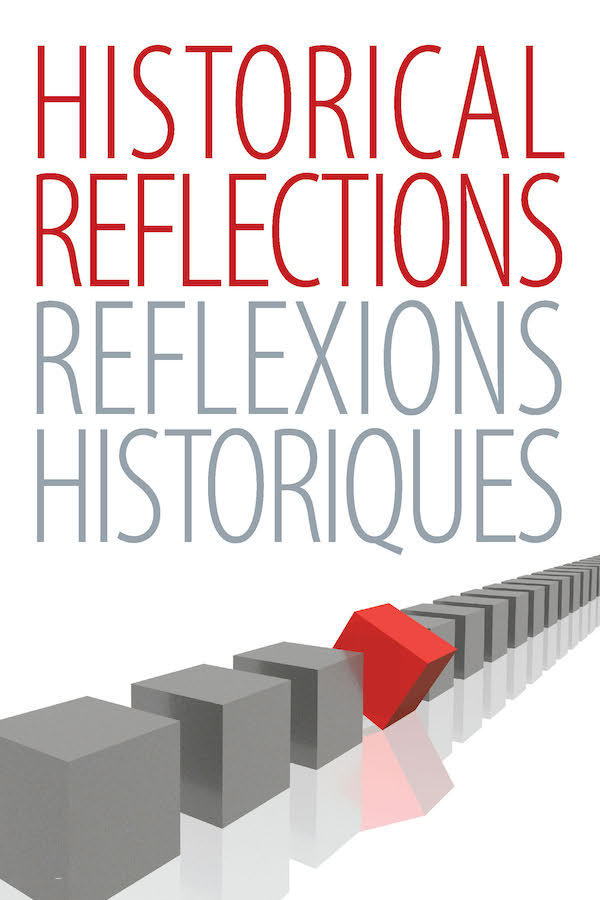
Historical Reflections/Réflexions Historiques
ISSN: 0315-7997 (print) • ISSN: 1939-2419 (online) • 3 issues per year
Editor: Elisabeth C. Macknight, Independent Scholar
Co-Editor: W. Brian Newsome, Georgia College and State University, USA
Subjects: History, Literature
![]() Available on JSTOR
Available on JSTOR
Latest Issue
Volume 51 Issue 2
Introduction
The special issue “Quantifying the English Archive: Interdisciplinary Perspectives on the Administrative and Social Histories of Medieval England” showcases recent developments in the application of quantitative and digital methodologies to medieval administrative records. This introduction provides a brief overview of scholarship from the last fifty years that used numerical data derived from written texts to reveal new information about daily life in medieval England. It then summarizes the major findings and contributions of the six articles in the issue, each of which employs quantitative analysis of archival records to study previously under-explored communities, places, and institutions.
Communities, Custom, and Canon Law
Elections of Benedictine Monastic Superiors in the Diocese of Lincoln, 1183–1340
Following the Fourth Lateran Council, the Benedictine Order became increasingly centralized. Individual houses, however, maintained a strong sense of their own privileges and identity as independent communities. The tension between communal autonomy and the enforcement of canon law was exhibited and tested in the process of abbatial election. This article takes as a case study the diocese of Lincoln, England's largest medieval diocese, which offers the largest sample of Benedictine monastic superiors. Using episcopal registers alongside monastic cartularies and customaries, it examines the process and significance of the election of monastic superiors. The article also seeks to integrate the study of male and female monasteries and to study relationships between individual houses and both secular and ecclesiastical hierarchies. The research findings come from the author's database of all known monastic superiors of independent Benedictine houses in the diocese of Lincoln from 1183–1340.
Convocation
Taxes, Petitions, and the Quest for the Medieval English Church's Autonomy
Convocation was the assembly of the clergy of medieval England and Wales and met from the late 1280s until the seventeenth century (before a rebirth in the nineteenth century). Economic historians have largely examined Convocation as a rubber stamp for stand-alone tax requests by the English kings or focused on small groupings of these demands—an examination of these requests and the evolution of how they were handled by the members of Convocation has not been covered. In this article, tax subsidy requests by the kings to Convocation are examined across three centuries in conjunction with clerical petitions to the monarchy allowing us to determine trends, including how the clergy went from ignoring requests to granting them with conditions. By placing these requests in their situational context, we can trace the efforts for self-rule and autonomy by the English clergy in the later Middle Ages.
Vadia Guerre
Contextualizing the War Wages of William de Farley's Wardrobe Account, 1359–1360
English campaigns in France during the Hundred Years War were military operations and significant governmental undertakings. The monarchy needed to mobilize and deploy men, animals, and equipment across the Channel to wage war in France. Once assembled, the English army employed a complex administrative system to ensure its soldiers were funded and resourced, leaving records of financial expenditures. The often-cited
The Romney Marsh Tax Records of the Thirteenth and Fourteenth Centuries
Charting Economic and Social Change in a Landscape in Crisis
Medieval Romney Marsh, a system of wetlands in southeast England, was a valuable landscape—densely settled and agriculturally productive. At the same time, however it was environmentally vulnerable to the series of crises associated with the end of the Medieval Climate Anomaly: flooding, famine, and disease-induced demographic collapse and labor shortages. A marsh government, designed to maintain the Romney Marsh sea defenses, conducted a series of detailed tax assessments across the Marsh between the mid-thirteenth and late fourteenth century, bridging this period of transition. These assessments offer an invaluable window into the intersection of environmental stress and the Marsh's social structure, revealing both a surprising resilience in the tenant sector and the vulnerability of demesne grain farms.
Visualizing Elizabeth of York's Ladies-in-Waiting
Medieval ladies-in-waiting were sophisticated players who earned significant rewards and engaged in power politics. This article quantifies and visualizes how female attendants accessed royal power and influence during the reign of Elizabeth of York (d. 1503), consort of Henry VII (r. 1485–1509). Using prosopographical techniques to build a collective biography of Elizabeth's highborn servants, analyzed with three related Microsoft Access databases, the investigation uncovered over 350 references to their activities. Employing
Social Space and Urban Drinking Houses in Medieval England
This article presents a quantitative analysis of English court records to enhance our understanding of urban drinking establishments from the thirteenth to the fifteenth century. The data is analyzed in three interrelated ways. First, the physical space of taverns and alehouses is considered with a focus on their layout, the signage they used, and the naming conventions they employed. The second section focuses on the gendering of these spaces and concludes, based in part on the number of women that could be found as both patrons and proprietors, that they should not be conceptualized solely as masculine spaces. The final section argues that drinking houses functioned primarily as social spaces that allowed for entertainment and gregarious activities despite concerns about the moral and physical dangers they presented.